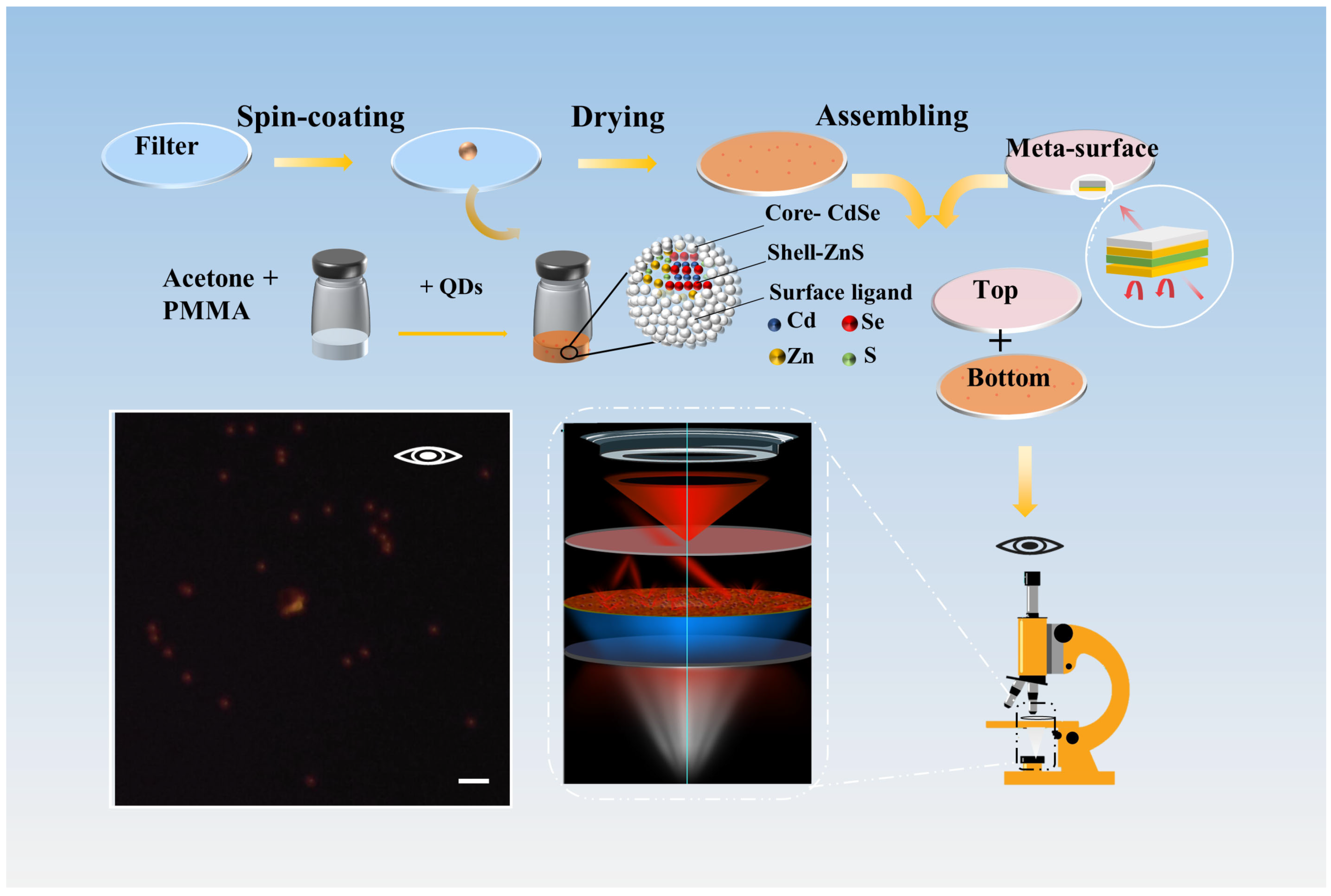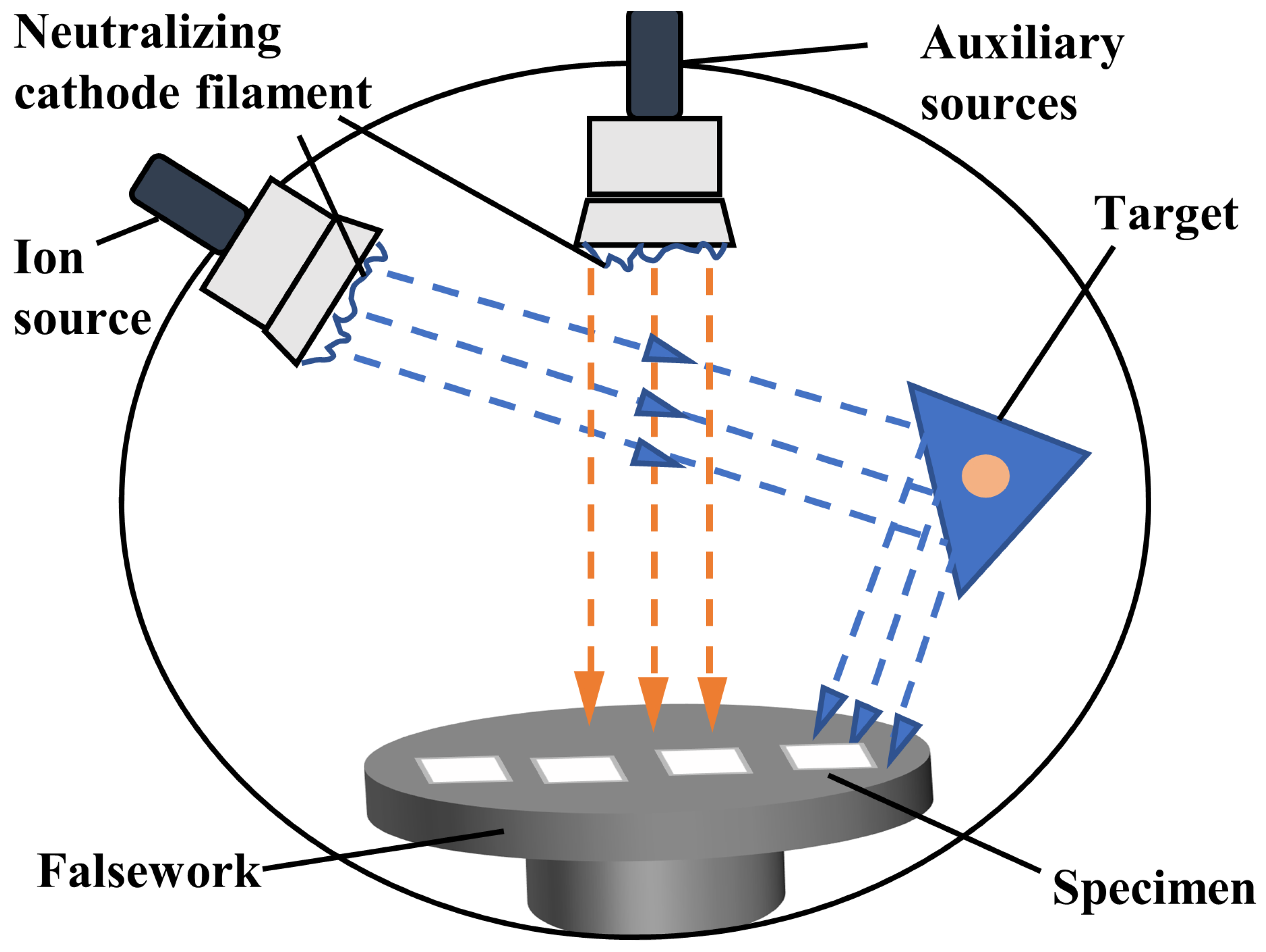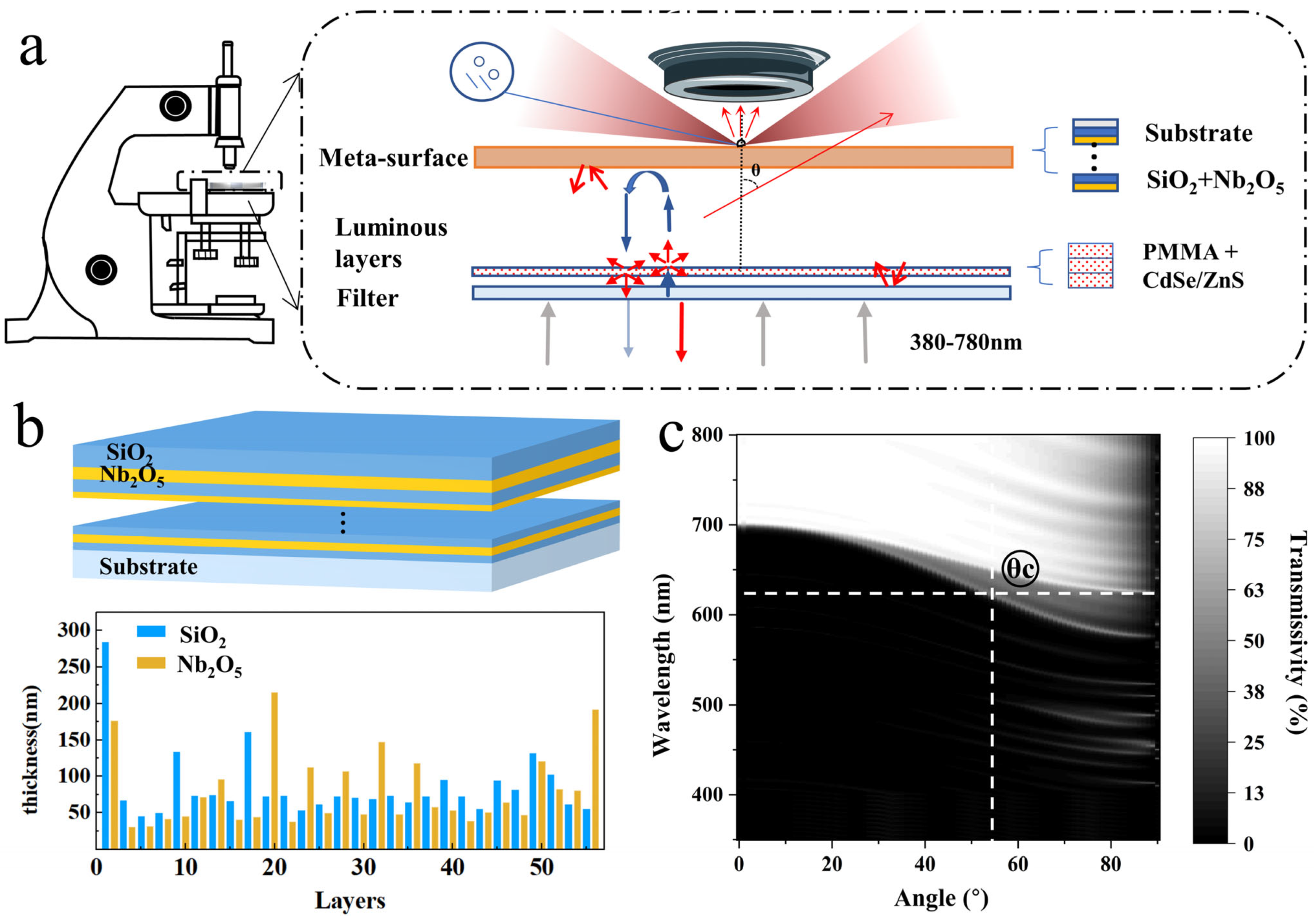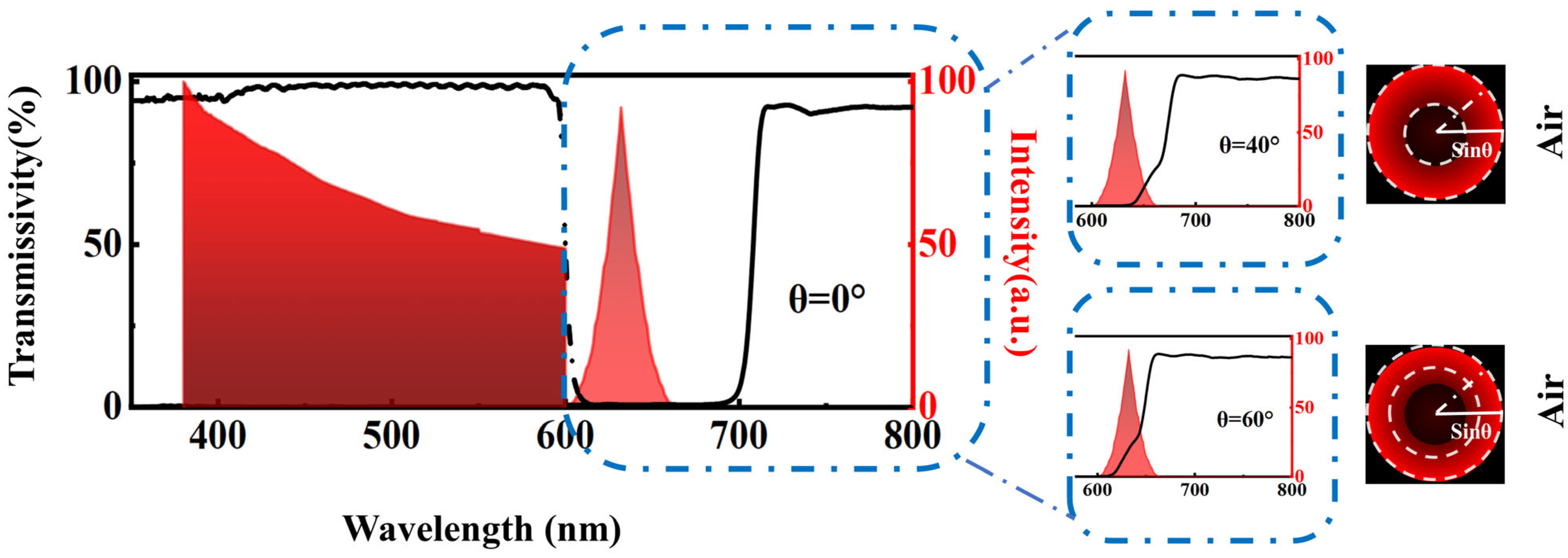Meta-Surface Slide for High-Contrast Dark-Field Imaging
Abstract
1. Introduction
2. Preparation and Testing Methods
2.1. Fabrication of the Meta-Surface
2.2. Preparation of Optical Frequency Conversion Layer
2.3. Characterization and Spectral Testing
3. Structure and Design Principle of the Slide
3.1. Simulation of the Mate-Surface Slide
3.2. Testing of the Meta-Surface Slide
4. Experiments
5. Conclusions
Author Contributions
Funding
Institutional Review Board Statement
Informed Consent Statement
Data Availability Statement
Conflicts of Interest
References
- Reinhardt, S.C.; Masullo, L.A.; Baudrexel, I.; Steen, P.R.; Kowalewski, R.; Eklund, A.S.; Strauss, S.; Unterauer, E.M.; Schlichthaerle, T.; Strauss, M.T. Ångström-resolution fluorescence microscopy. Nature 2023, 617, 711–716. [Google Scholar] [CrossRef] [PubMed]
- Cnossen, J.; Hinsdale, T.; Thorsen, R.Ø.; Siemons, M.; Schueder, F.; Jungmann, R.; Smith, C.S.; Rieger, B.; Stallinga, S. Local-ization microscopy at doubled precision with patterned illumination. Nat. Methods 2020, 17, 59–63. [Google Scholar] [CrossRef]
- Weber, M.; Leutenegger, M.; Stoldt, S.; Jakobs, S.; Mihaila, T.S.; Butkevich, A.N.; Hell, S.W. MINSTED fluorescence localization and nanoscopy. Nat. Photonics 2021, 15, 361–366. [Google Scholar] [CrossRef] [PubMed]
- Masullo, L.A.; Szalai, A.M.; Lopez, L.F.; Pilo-Pais, M.; Acuna, G.P.; Stefani, F.D. An alternative to MINFLUX that ena-bles nanometer resolution in a confocal microscope. Light Sci. Appl. 2022, 11, 199. [Google Scholar] [CrossRef] [PubMed]
- Lelek, M.; Gyparaki, M.T.; Beliu, G.; Schueder, F.; Griffié, J.; Manley, S.; Jungmann, R.; Sauer, M.; Lakadamyali, M.; Zimmer, C. Single-molecule localization microscopy. Nat. Rev. Methods Prim. 2021, 1, 39. [Google Scholar] [CrossRef]
- Synge, E. London, Edinburgh Dublin Philos. Mag. J. Sci. 1928, 6, 356. [Google Scholar] [CrossRef]
- Pohl, D.W.; Denk, W.; Lanz, M. Optical stethoscopy: Image recording with resolution λ/20. Appl. Phys. Lett. 1984, 44, 651–653. [Google Scholar] [CrossRef]
- Betzig, E.; Trautman, J.K.; Harris, T.D.; Weiner, J.S.; Kostelak, R.L. Breaking the Diffraction Barrier: Optical Microscopy on a Nanometric Scale. Science 1991, 251, 1468–1470. [Google Scholar] [CrossRef]
- Anger, P.; Bharadwaj, P.; Novotny, L. Enhancement and Quenching of Single-Molecule Fluorescence. Phys. Rev. Lett. 2006, 96, 113002. [Google Scholar] [CrossRef]
- Betzig, E.; Patterson, G.H.; Sougrat, R.; Lindwasser, O.W.; Olenych, S.; Bonifacino, J.S.; Davidson, M.W.; Lippincott-Schwartz, J.; Hess, H.F. Imaging Intracellular Fluorescent Proteins at Nanometer Resolution. Science 2006, 313, 1642–1645. [Google Scholar] [CrossRef]
- Hess, S.T.; Girirajan, T.P.; Mason, M.D. Ultra-High Resolution Imaging by Fluorescence Photoactivation Localization Microscopy. Biophys. J. 2006, 91, 4258–4272. [Google Scholar] [CrossRef] [PubMed]
- Gustafsson, M.G. Surpassing the lateral resolution limit by a factor of two using structured illumination microscopy. J. Microsc. 2000, 198, 82–87. [Google Scholar] [CrossRef]
- Gustafsson, M.G. Nonlinear structured-illumination microscopy: Wide-field fluorescence imaging with theoretically unlim-ited resolution. Proc. Natl. Acad. Sci. USA 2005, 102, 13081–13086. [Google Scholar] [CrossRef] [PubMed]
- Hell, S.W.; Wichmann, J. Breaking the diffraction resolution limit by stimulated emission: Stimulated-emission-depletion fluorescence microscopy. Opt. Lett. 1994, 19, 780–782. [Google Scholar] [CrossRef] [PubMed]
- Klar, T.; Hell, S.W. Subdiffraction resolution in far-field fluorescence microscopy. Opt. Lett. 1999, 24, 954–956. [Google Scholar] [CrossRef]
- Rust, M.J.; Bates, M.; Zhuang, X. Sub-diffraction-limit imaging by stochastic optical reconstruction microscopy (STORM). Nat. Methods 2006, 3, 793–796. [Google Scholar] [CrossRef]
- Murphy, D.B.; Davidson, M.W. Fundamentals of Light Microscopy and Electronic Imaging; John Wiley & Sons: Hoboken, NJ, USA, 2012. [Google Scholar]
- Diekmann, R.; Helle, Ø.I.; Øie, C.I.; McCourt, P.; Huser, T.R.; Schüttpelz, M.; Ahluwalia, B.S. Chip-based wide field-of-view nanoscopy. Nat. Photon. 2017, 11, 322–328. [Google Scholar] [CrossRef]
- Helle, Ø.I.; Dullo, F.T.; Lahrberg, M.; Tinguely, J.-C.; Hellesø, O.G.; Ahluwalia, B.S. Structured illumination microscopy using a photonic chip. Nat. Photon. 2020, 14, 431–438. [Google Scholar] [CrossRef]
- Ruh, D.; Mutschler, J.; Michelbach, M.; Rohrbach, A. Superior contrast and resolution by image formation in rotating coherent scattering (ROCS) microscopy. Optica 2018, 5, 1371–1381. [Google Scholar] [CrossRef]
- Noda, N.; Kamimura, S. A new microscope optics for laser dark-field illumination applied to high precision two dimensional measurement of specimen displacement. Rev. Sci. Instrum. 2008, 79, 023704. [Google Scholar] [CrossRef]
- Hu, H.; Ma, C.; Liu, Z. Plasmonic dark field microscopy. Appl. Phys. Lett. 2010, 96, 113107. [Google Scholar] [CrossRef]
- Gage, S.H. Modern Dark-Field Microscopy and the History of Its Development. Trans. Am. Microsc. Soc. 1920, 39, 95. [Google Scholar] [CrossRef]
- Hecht, E. Optics, 3rd ed.; Addison-Wesley: Boston, TX, USA, 1998; p. 330. [Google Scholar]
- Sabri, L.; Huang, Q.; Liu, J.-N.; Cunningham, B.T. Design of anapole mode electromagnetic field enhancement structures for biosensing applications. Opt. Express 2019, 27, 7196–7212. [Google Scholar] [CrossRef] [PubMed]
- Yesilkoy, F.; Arvelo, E.R.; Jahani, Y.; Liu, M.; Tittl, A.; Cevher, V.; Kivshar, Y.; Altug, H. Ultrasensitive hyperspectral imaging and biodetection enabled by dielectric metasurfaces. Nat. Photon. 2019, 13, 390–396. [Google Scholar] [CrossRef]
- Soukoulis, C.M.; Wegener, M. Past achievements and future challenges in the development of three-dimensional pho-tonic metamaterials. Nat. Photonics 2011, 5, 523–530. [Google Scholar] [CrossRef]
- Tong, X.C. Photonic Metamaterials and Metadevices. In Functional Metamaterials and Metadevices; Springer: Bolingbrook, IL, USA, 2018; pp. 71–106. [Google Scholar] [CrossRef]
- Iwanaga, M. Photonic metamaterials: A new class of materials for manipulating light waves. Sci. Technol. Adv. Mater. 2012, 13, 053002. [Google Scholar] [CrossRef]
- Salim, A.; Lim, S. Review of Recent Metamaterial Microfluidic Sensors. Sensors 2018, 18, 232. [Google Scholar] [CrossRef]
- Xu, W.; Xie, L.; Ying, Y. Mechanisms and applications of terahertz metamaterial sensing: A review. Nanoscale 2017, 9, 13864–13878. [Google Scholar] [CrossRef]
- Ahmadivand, A.; Gerislioglu, B.; Ahuja, R.; Mishra, Y.K. Terahertz plasmonics: The rise of toroidal metadevices towards immunobiosensings. Mater. Today 2020, 32, 108–130. [Google Scholar] [CrossRef]
- Balaur, E.; Cadenazzi, G.A.; Anthony, N.; Spurling, A.; Hanssen, E.; Orian, J.; Nugent, K.A.; Parker, B.S.; Abbey, B. Plasmon-induced enhancement of ptychographic phase microscopy via subsurface nanoaperture arrays. Nat. Photonics 2021, 15, 222–229. [Google Scholar] [CrossRef]
- Popescu, G. Quantitative Phase Imaging of Cells and Tissues; McGraw-Hill Education: New York, NY, USA, 2011. [Google Scholar]
- Kwon, H.; Arbabi, E.; Kamali, S.M.; Faraji-Dana, M.; Faraon, A. Single-shot quantitative phase gradient microscopy using a system of multifunctional metasurfaces. Nat. Photon. 2020, 14, 109–114. [Google Scholar] [CrossRef]
- Zheng, G.; Cui, X.; Yang, C. Surface-wave-enabled darkfield aperture for background suppression during weak signal detection. Proc. Natl. Acad. Sci. 2010, 107, 9043–9048. [Google Scholar] [CrossRef]
- Zhang, J.; Pitter, M.C.; Liu, S.; See, C.; Somekh, M.G. Surface-plasmon microscopy with a two-piece solid immersion lens: Bright and dark fields. Appl. Opt. 2006, 45, 7977–7986. [Google Scholar] [CrossRef]
- Balci, S.; Karademir, E.; Kocabas, C.; Aydinli, A. Direct imaging of localized surface plasmon polaritons. Opt. Lett. 2011, 36, 3401–3403. [Google Scholar] [CrossRef]
- Wei, F.; Li, G.; Cheah, K.W.; Liu, Z. Organic light-emitting-diode-based plasmonic dark-field microscopy. Opt. Lett. 2012, 37, 4359–4361. [Google Scholar] [CrossRef] [PubMed]
- Chazot, C.A.; Nagelberg, S.; Rowlands, C.J.; Scherer, M.R.J.; Coropceanu, I.; Broderick, K.; Kim, Y.; Bawendi, M.G.; So, P.T.C.; Kolle, M. Luminescent surfaces with tailored angular emission for compact dark-field imaging devices. Nat. Photon. 2020, 14, 310–315. [Google Scholar] [CrossRef]
- Vukusic, P.; Sambles, J.R.; Lawrence, C.R. Colour mixing in wing scales of a butterfly. Nature 2000, 404, 457. [Google Scholar] [CrossRef] [PubMed]
- Vukusic, P.; Sambles, J.R.; Lawrence, C.R.; Wakely, G. Sculpted-multilayer optical effects in two species of Papilio butterfly. Appl. Opt. 2001, 40, 1116–1125. [Google Scholar] [CrossRef]
- Kuai, Y.; Chen, J.; Fan, Z.; Zou, G.; Lakowicz, J.R.; Zhang, D. Planar photonic chips with tailored angular transmission for high-contrast-imaging devices. Nat. Commun. 2021, 12, 1–9. [Google Scholar] [CrossRef] [PubMed]
- Magnusson, R.; Wang, S.S. New principle for optical filters. Appl. Phys. Lett. 1992, 61, 1022–1024. [Google Scholar] [CrossRef]
- Wang, S.S.; Magnusson, R. Theory and applications of guided-mode resonance filters. Appl. Opt. 1993, 32, 2606–2613. [Google Scholar] [CrossRef] [PubMed]
- Wang, S.S.; Magnusson, R. Design of waveguide-grating filters with symmetrical line shapes and low sidebands. Opt. Lett. 1994, 19, 919–921. [Google Scholar] [CrossRef] [PubMed]
- Chen, R.; Wang, Y.; Guo, K.; Zhang, Y.; Wang, Z.; Zhu, M.; Yi, K.; Leng, Y.; Shao, J. Angle-adjustment-based tunable chirped mirrors with continuous dispersion compensation. Opt. Lett. 2019, 44, 6053–6056. [Google Scholar] [CrossRef] [PubMed]






Disclaimer/Publisher’s Note: The statements, opinions and data contained in all publications are solely those of the individual author(s) and contributor(s) and not of MDPI and/or the editor(s). MDPI and/or the editor(s) disclaim responsibility for any injury to people or property resulting from any ideas, methods, instructions or products referred to in the content. |
© 2023 by the authors. Licensee MDPI, Basel, Switzerland. This article is an open access article distributed under the terms and conditions of the Creative Commons Attribution (CC BY) license (https://creativecommons.org/licenses/by/4.0/).
Share and Cite
Shao, J.; Chen, R.; Zhu, D.; Cao, Y.; Liu, W.; Xue, W. Meta-Surface Slide for High-Contrast Dark-Field Imaging. Photonics 2023, 10, 775. https://doi.org/10.3390/photonics10070775
Shao J, Chen R, Zhu D, Cao Y, Liu W, Xue W. Meta-Surface Slide for High-Contrast Dark-Field Imaging. Photonics. 2023; 10(7):775. https://doi.org/10.3390/photonics10070775
Chicago/Turabian StyleShao, Jianan, Ruiyi Chen, Dehua Zhu, Yu Cao, Wenwen Liu, and Wei Xue. 2023. "Meta-Surface Slide for High-Contrast Dark-Field Imaging" Photonics 10, no. 7: 775. https://doi.org/10.3390/photonics10070775
APA StyleShao, J., Chen, R., Zhu, D., Cao, Y., Liu, W., & Xue, W. (2023). Meta-Surface Slide for High-Contrast Dark-Field Imaging. Photonics, 10(7), 775. https://doi.org/10.3390/photonics10070775




